Kimbap (Korean Seaweed Rice Roll)
Kimbap, also known as Gimbap, is a traditional Korean seaweed rice roll that consists of rice, vegetables, and seaweed. This recipe with step-by-step video tutorial provides an easy way to make the flavorful Korean rice dish, perfect for a quick meal-on-the-go or outdoor event.
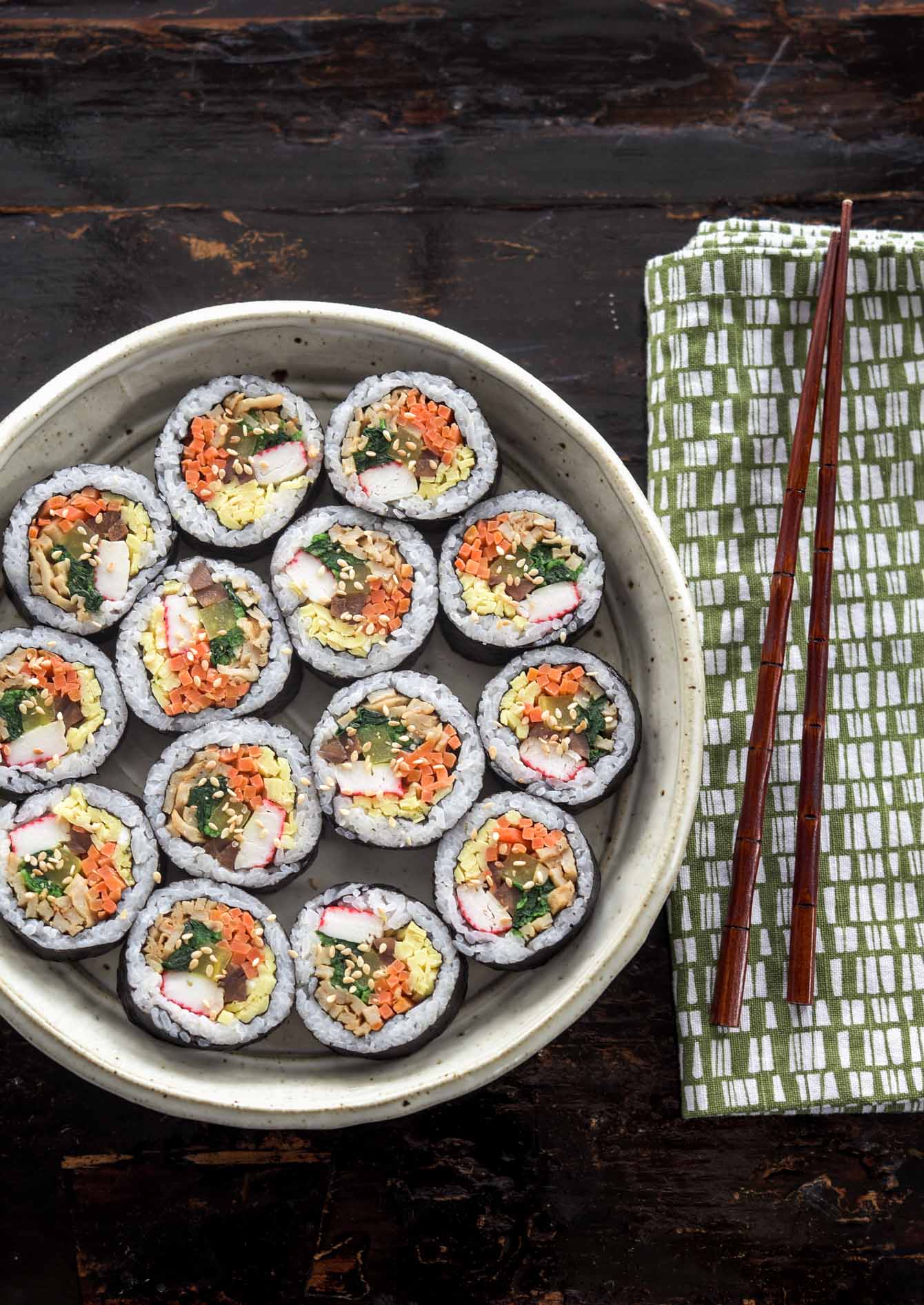
Every time I visit a Korean store, I can’t help but grab some store-made kimbap (김밥) – those delightful seaweed rice rolls – for a quick snack on my drive home. Yet, more often than not, I end up wishing I had made them myself.
The taste of homemade kimbap is incomparably better. While it does take a bit of time and effort to prepare them at home, the process isn’t as difficult as it might seem. And it’s fun to make.
I’m excited to share my personal kimbap recipe with you, a cherished family secret handed down from my mother. Her kimbap was famous in our small South Korean town, often winning the first prize for the kimbap taste contest at school picnics.
The secret to its deliciousness is something I’m eager to reveal in this post. I hope you’ll give it a try and find it as enjoyable as I have throughout the years.
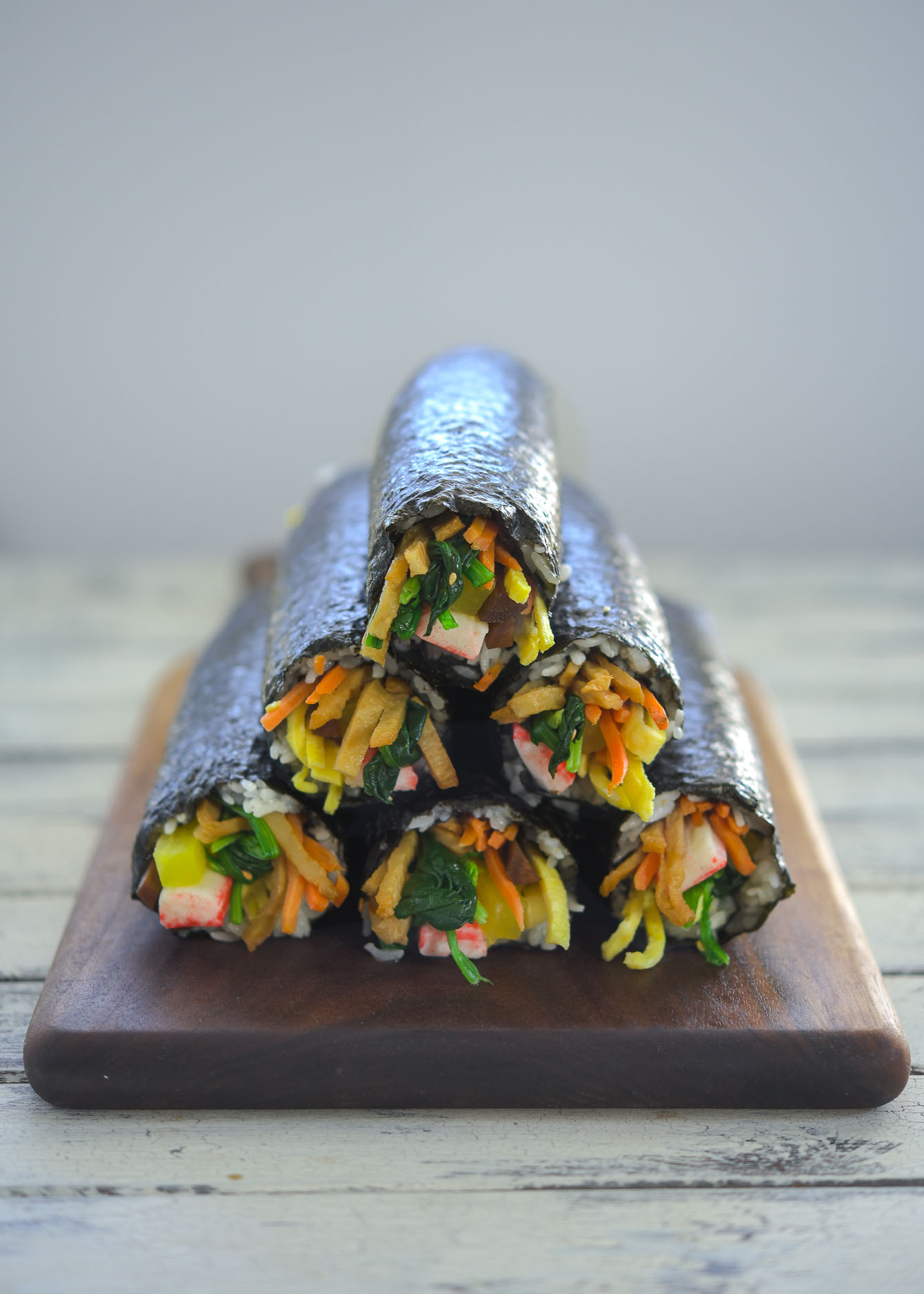
What is Kimbap?
Kimbap, also spelled as gimbap, is a popular Korean dish that means “seaweed and rice.” These Korean rice roll is often enjoyed as a quick meal-on-the-go or snack that you see in many shops around bus or train station.
It involves rolling rice in a seaweed sheet and adding various fillings. The fillings can be almost anything you like, ranging from tuna, kimchi, chicken, shrimp, spicy pork, to bulgogi. Tuna kimbap and bulgogi kimbap are the popular variations.
You can stick to classic fillings like pickled radish, imitation crab, ham, braised burdock root, egg, carrot, fishcake, and cucumber. Or, get creative and use whatever ingredients you have in your kitchen for a modern twist.
While these seaweed rice rolls might look like it takes a lot of work because of the different ingredients you need to prepare, it’s actually not too hard to make. Plus, it’s an affordable, fulfilling dish that looks great, making it perfect for parties or as finger food.
Kimbap vs Sushi
While kimbap and sushi may appear similar at first glance, they have distinct differences. Kimbap, a traditional Korean dish, combines rice and seaweed with a variety of fillings such as vegetables, meat, or fish. The rice is seasoned with sesame oil and sometimes a bit of sugar, giving it a unique flavor.
Sushi, on the other hand, is a Japanese dish. It also uses rice and seaweed, but the rice is seasoned with vinegar, sugar, and salt. Sushi often includes raw fish, unlike kimbap which usually has cooked or pickled ingredients.
Dried Seaweed Sheets (Gim)
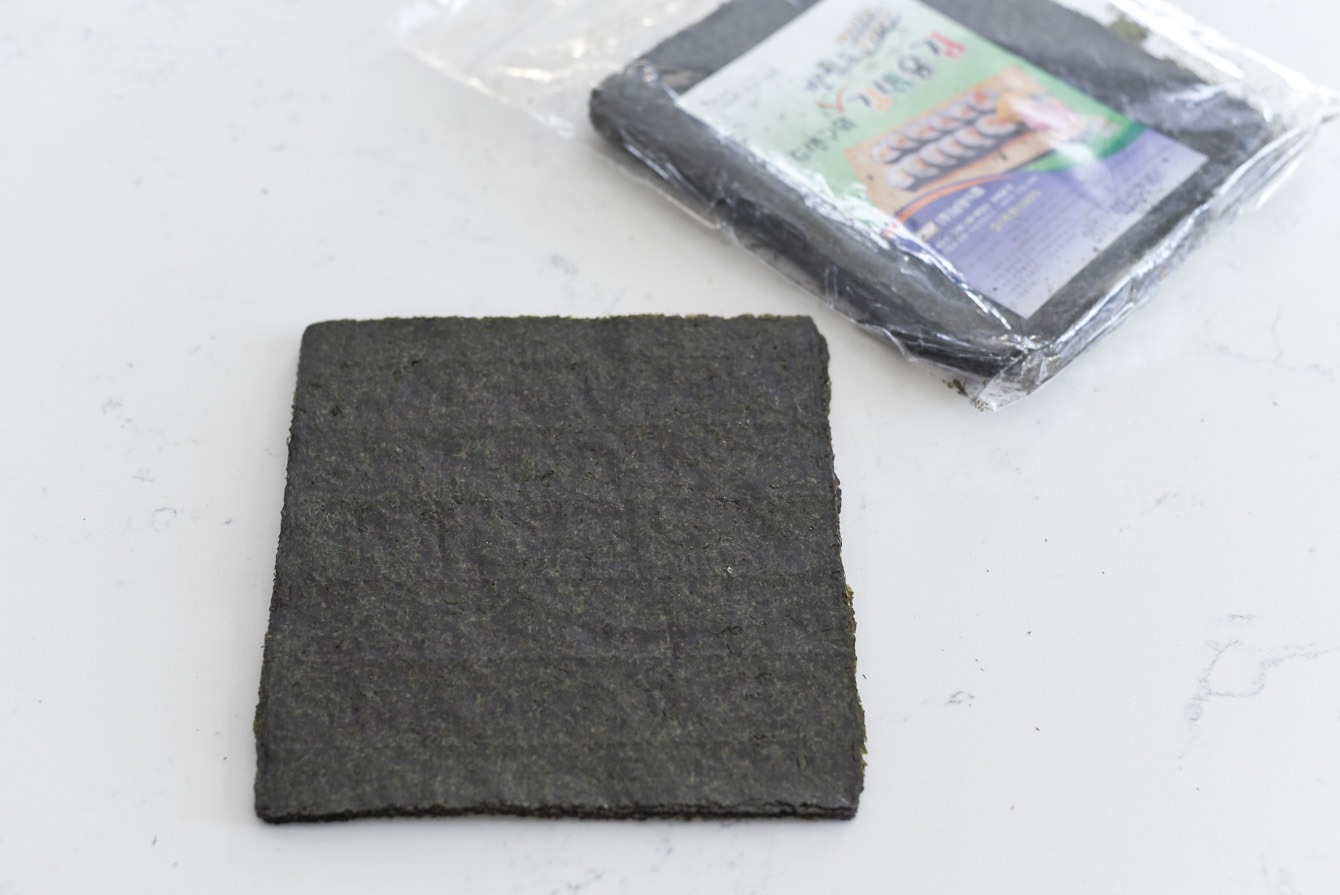
When you’re at a Korean grocery store, you’ll see different kinds of seaweed. You need to pick the right type: look for dark, dense, and roasted seaweed sheets, known as Gim (김) or nori sheet. These sheets are perfect for rolling Korean rice rolls.
When choosing seaweed sheets, avoid any that have red or purple spots. This color change means the seaweed is old and might not taste good anymore.
After you open a pack of seaweed, it’s a good idea to store any leftovers in the freezer. This helps keep the seaweed fresh for longer. Seaweed can spoil quickly if it’s left out in light or damp places.
For more details about Korean seaweed, check out the pantry section of my blog.
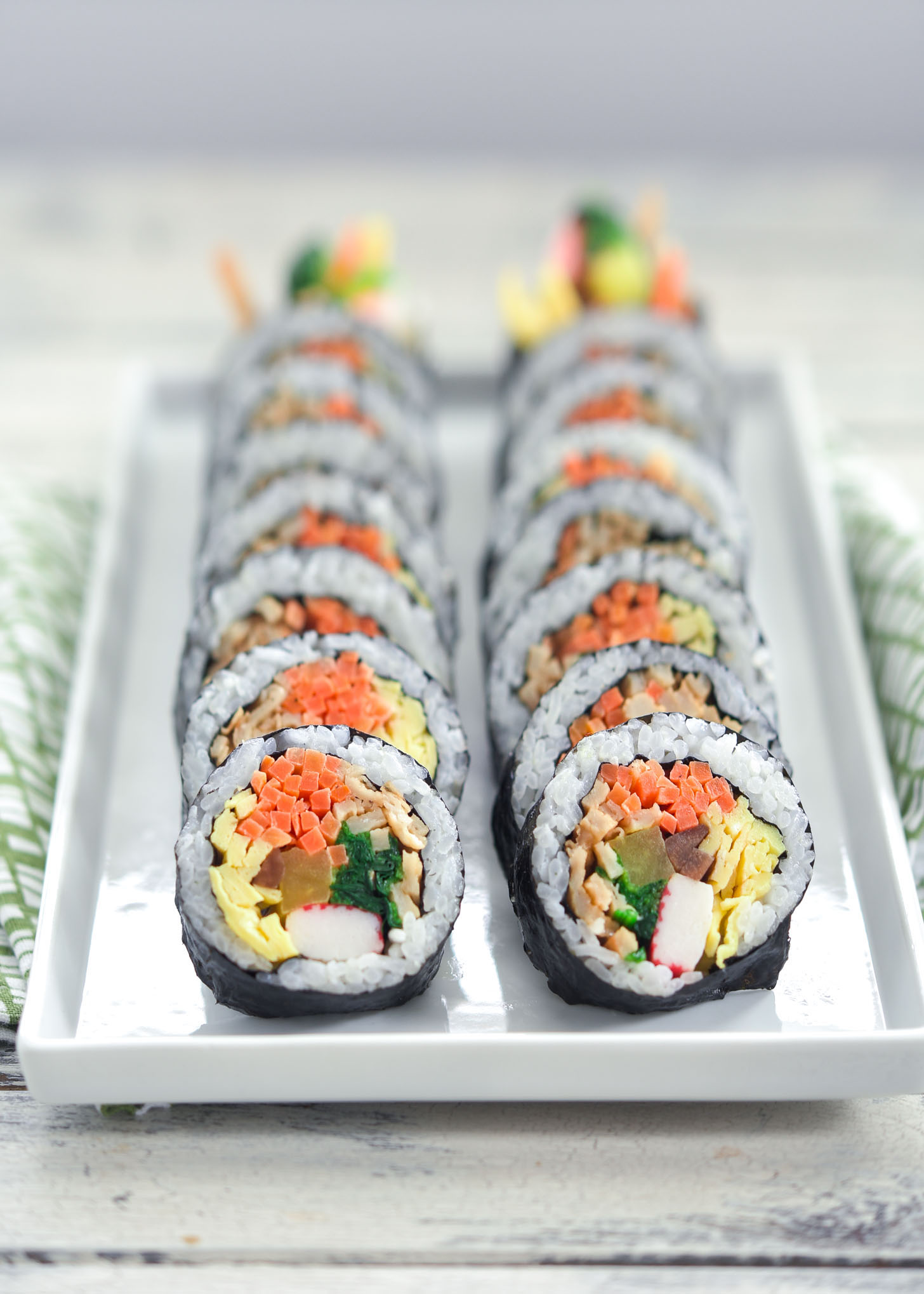
Rice
When making Korean rice roll, it’s best to use short or medium grain white rice. This type of rice is stickier than long grain rice, which helps it stick to the seaweed sheets better. For the perfect texture, cook the rice with a little less water than you normally would.
There are two popular ways to season the rice:
- Sesame Oil and Salt: This is a common choice. It gives the rice a nice flavor that goes well with the other ingredients.
- Korean plum extract (mashil chung, 매실청) and Salt: If you’re not keen on the strong smell of sesame oil, try using Korean plum extract. It adds a different but delicious taste.
Personally, my mother always used Korean plum extract for the rice seasoning, and everyone loved it.
Other Ingredients
Korean seaweed roll fillings offer a wide range of options to choose from. Here are some popular options for you to consider:
- For vegetables: spinach, carrot, cucumber, Asian chives, watercress, perilla leaves, lettuce
- For pickled vegetables: radish pickles, cucumber pickles, jalapeno pickles, burdock roots
- For proteins: egg, canned tuna, beef, ham, bacon, pork or pork belly, shrimp tempura, seasoned anchovies, spicy shredded squid
- Other fillings: fishcakes, imitation crab meats, and etc
- Depending on the ingredients you choose, you can make your seaweed rice rolls vegan or vegetarian-friendly.
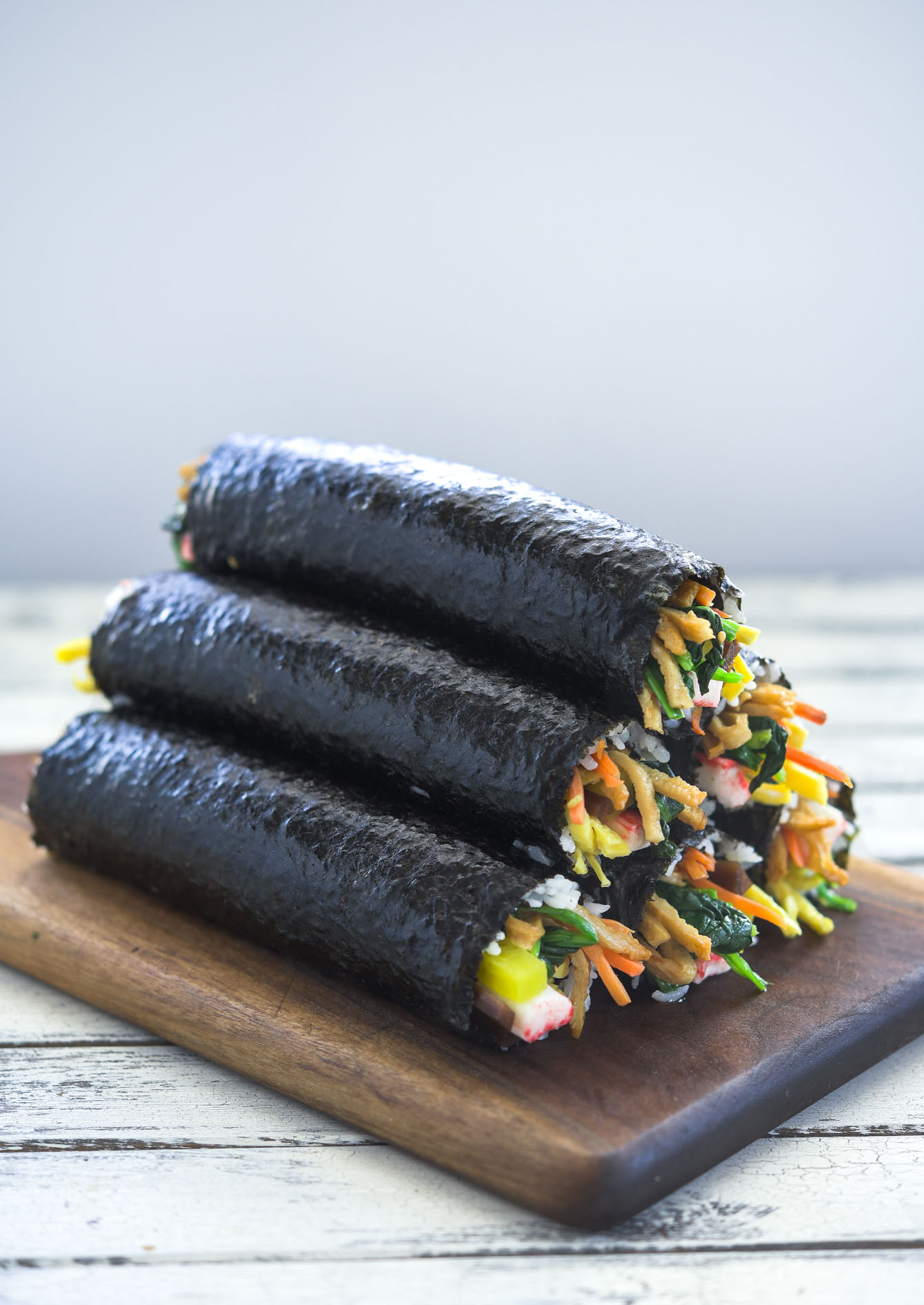
My Best Tips
- Use Freshly Cooked Rice: It’s best to make kimbap with rice that’s just been cooked. Keep the rice a bit warm until you’re ready to roll.
- Season Each Filling Lightly: Be careful with the seasoning, especially with ingredients like pickled radish and burdock roots, as they are already salty.
- Prevent Rice from Sticking: Before spreading rice on the seaweed, dampen your fingers with water or sesame oil. This stops the rice from sticking to your hands.
- Keeping a small bowl of water or sesame oil nearby is really helpful.
- Cut with a Sharp Knife: Use a sharp knife to cut your rice rolls. Aim for a smooth, single motion for each slice.
- Apply a little oil to the blade of your knife using a brush before slicing the seaweed rolls to prevent it from sticking to the knife.
- For a Neat Look: To give a tidy and appealing look, use an extra half-sheet of seaweed over the rice before adding the filling.
- This creates a clear border between the filling and the rice, enhancing the appearance.
How to make Kimbap
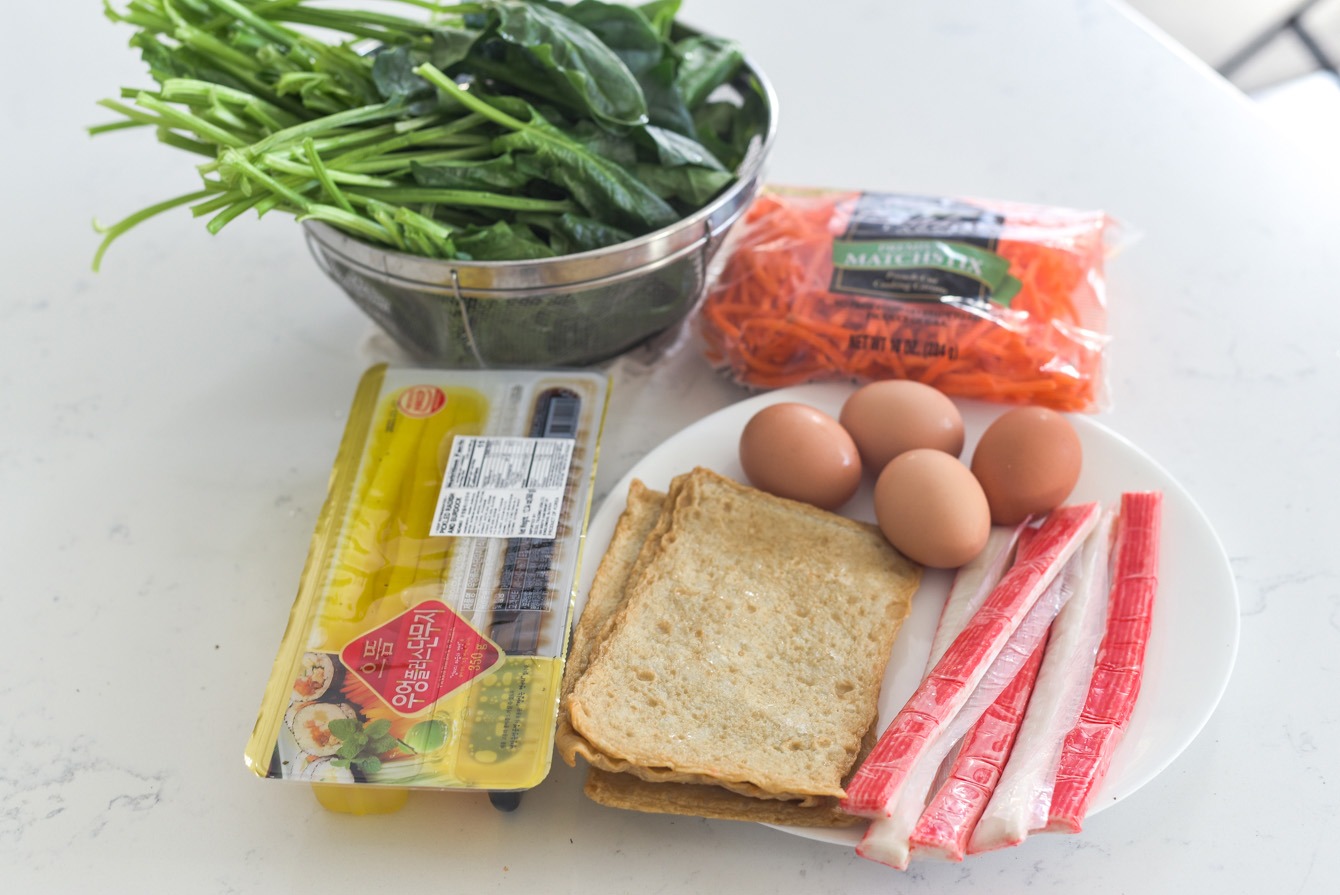
This recipe uses classic filling ingredients like spinach, carrot, egg, imitation crab meat, fish cake sheets, braised burdock roots, and radish pickles.
Preparing fillings
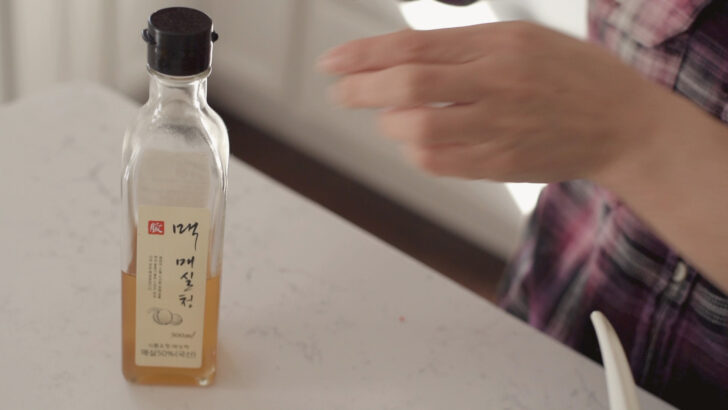
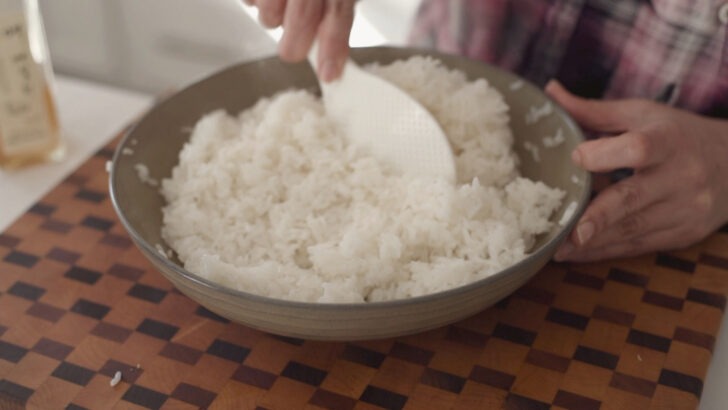
Step 1. Season the rice
- Drizzle Korean plum extract and a few pinches of salt over freshly cooked rice. Mix it well.
- Cover the rice with a kitchen towel and let it cool down slightly.
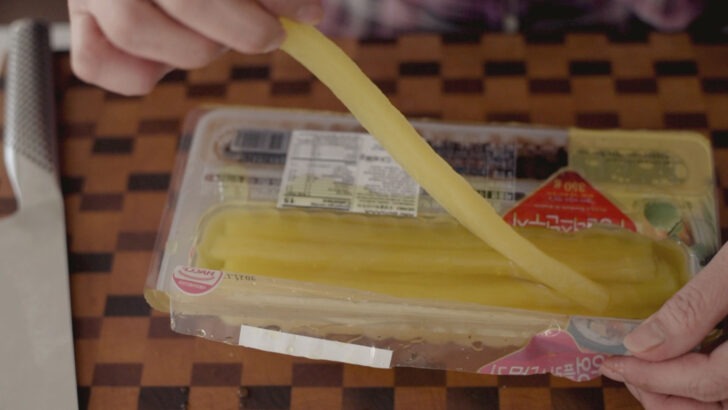
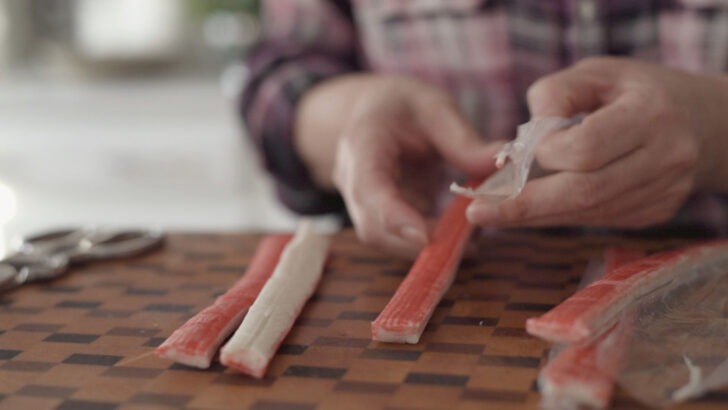
Step 2. Prep the fillings
- For convenience, use store-bought radish pickles and burdock roots, available at Korean grocery stores. Drain them well before use.
- Unwrap the imitation crab meat and keep it ready.
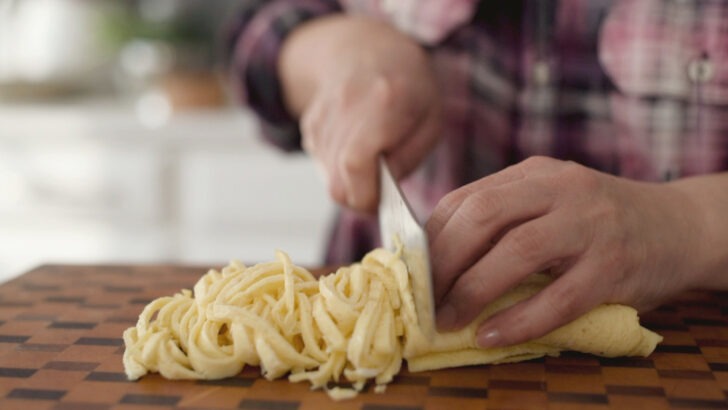

- Egg: Roll up the cooked egg and cut into thin slices.
- Carrot: Cook shredded carrot with a bit of oil and salt until crisp yet tender.
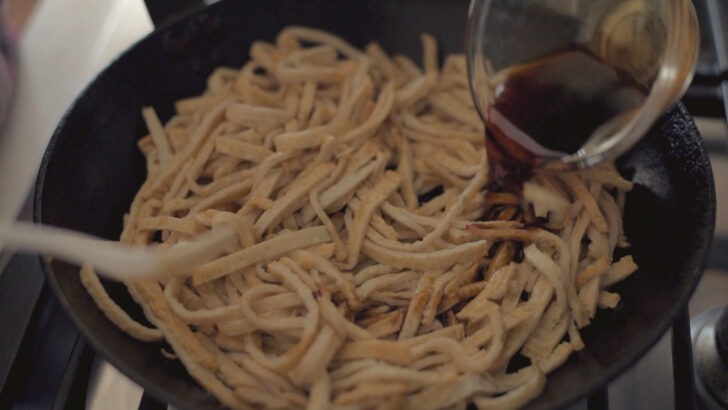
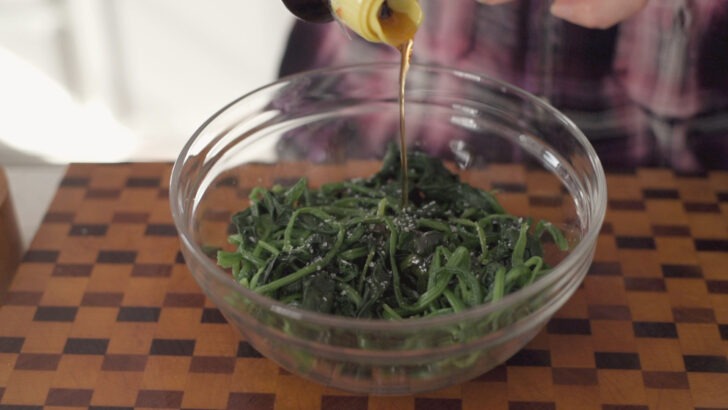
- Fishcake: Cut the fishcake sheets into thin slices and stir-fry in a soy sauce, sugar, rice wine mixture.
- Spinach: Season blanched spinach with salt, sesame oil, and sesame seeds.
How to Roll Kimbap
Rolling kimbap might seem tricky at first, especially if you’re new to it. But with a bit of practice, you’ll get the hang of it quickly. Beginners should use a bamboo mat for easier rolling, though experts can do it without one.
Here’s a step-by-step guide to get you started. Also, my recipe video below will help visualize the process:
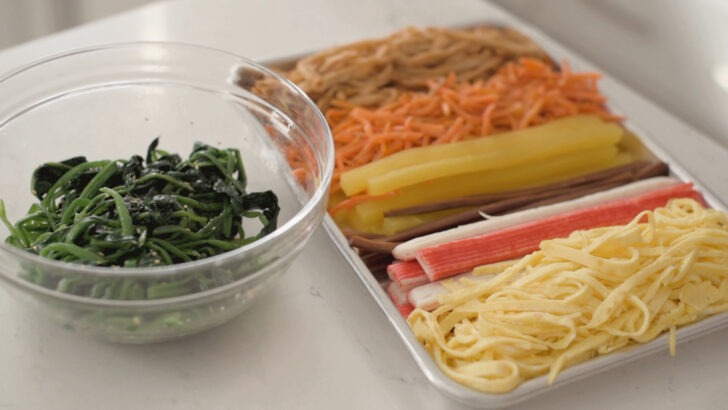
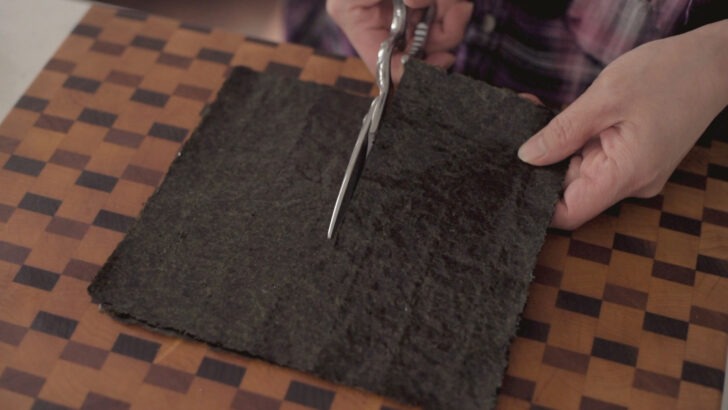
Step 1: Set up your filling station
- Get all your ingredients ready and organized in one place.
- Cut three seaweed sheets in half and keep them ready.
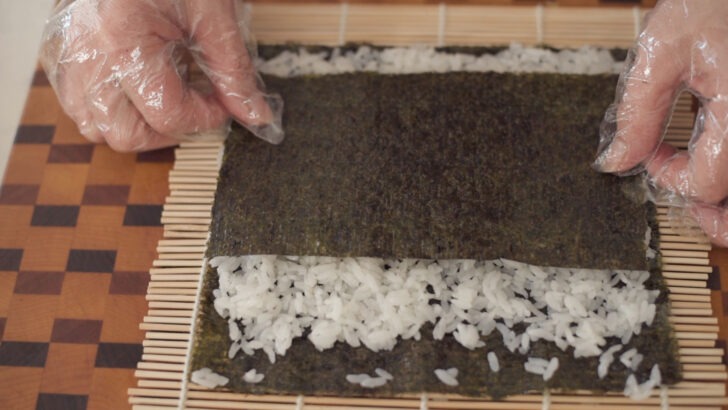

Step 2. Spread rice and arrange the fillings
- Place a full seaweed sheet with the shiny side down (rough side up) and the longer side facing you on a bamboo mat.
- Evenly spread about 1 cup of rice on the seaweed, leaving an inch free at the far end.
- In the middle of the rice, place a half sheet of seaweed. Arrange your fillings on this half sheet, creating a nice color contrast.
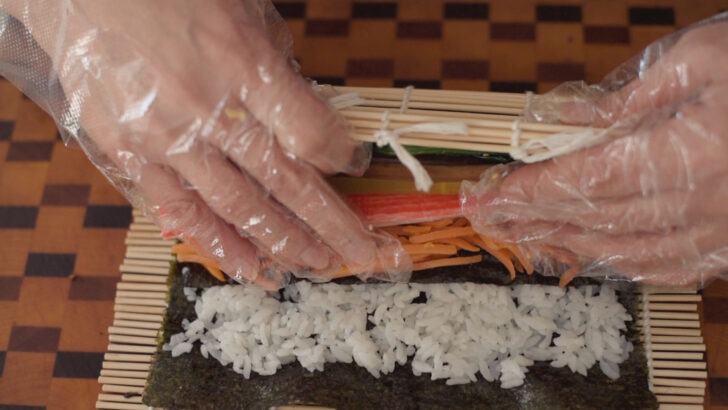
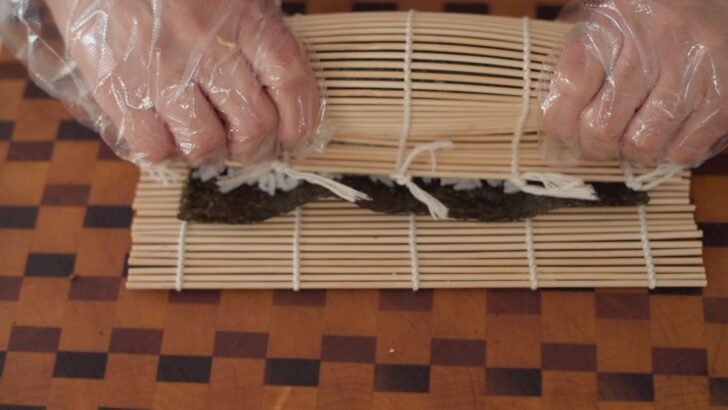
Step 3. Roll with bamboo mat
- Lift the edge of the bamboo mat closest to you, rolling it over the fillings. Use your fingers to keep the fillings in place.
- Apply firm pressure as you roll, gradually unrolling the mat until the roll is complete.
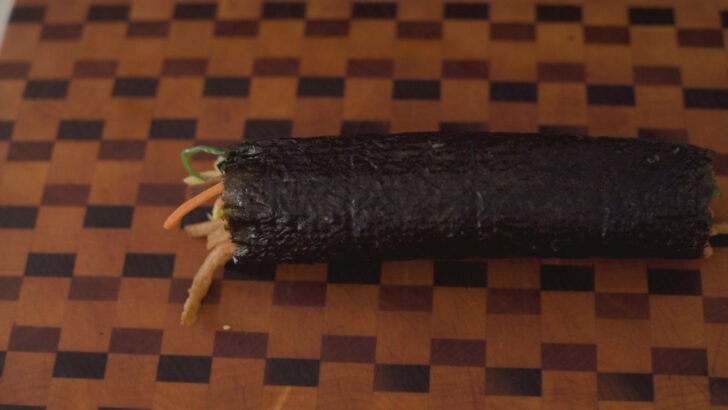
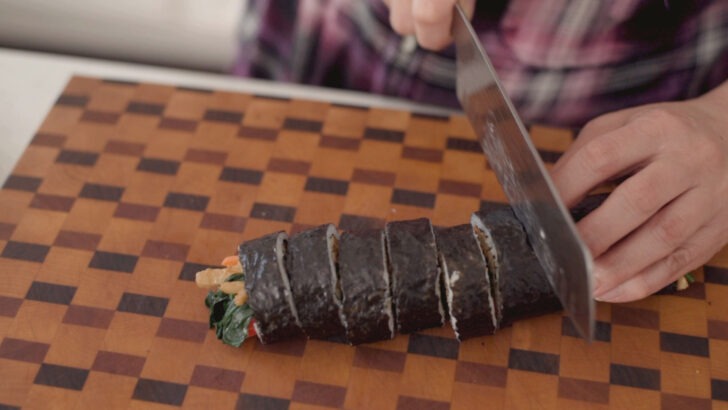
Step 4. Slice the roll
- Your roll should be even in thickness.
- Place the roll seam-side down on a plate while you make more.
- Slice the roll into 1/2 inch thick pieces using a sharp knife.
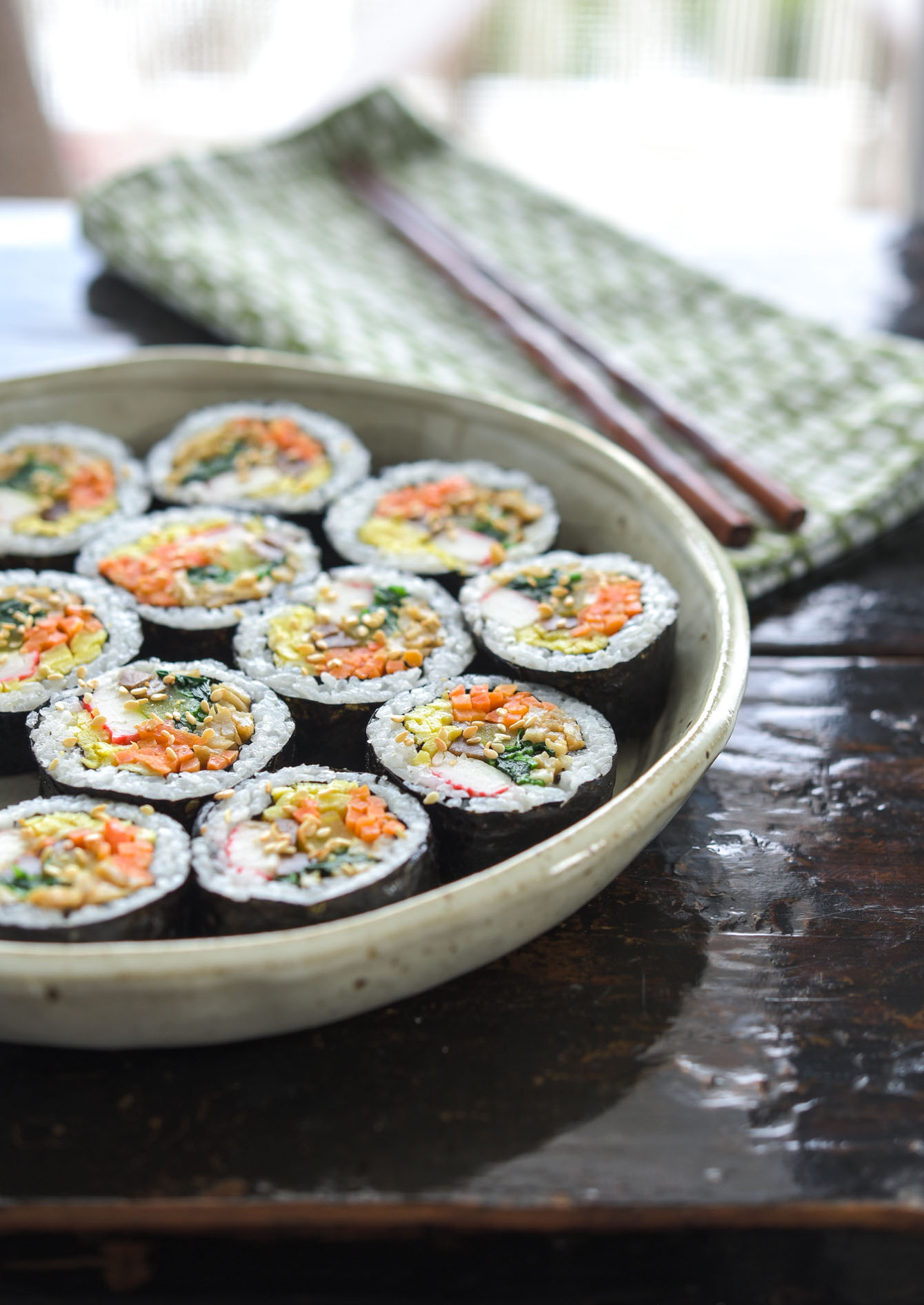
Storage Suggestion
Kimbap tastes best when eaten fresh, ideally on the same day it’s made. You can keep it at room temperature for a few hours, but it’s not a good idea to store it in the fridge for too long. The taste can change and it might not be as nice to eat.
If you need to store leftover kimbap for a longer time, freezing is a better option. Here’s how to do it:
- Cut the roll into individual slices.
- Wrap the roll tightly in plastic wrap or aluminum foil – one roll per wrap, similar to how frozen kimbap is sold at stores like Trader Joe’s.
- Put the wrapped rolls in a freezer-safe bag or container.
- To eat the frozen seaweed rice rolls, let it thaw at room temperature for up to an hour.
Just remember, the texture of the rice and some fillings might be a bit different after freezing and thawing. The seaweed might not be as crisp either. But it’s still a great way to enjoy later on!
Watch full Recipe Video
More Rice Dishes
Turn your boring leftover rice to make a delicious main dish. Try these favorite Korean rice recipes that people love.
- Bibimbap (Korean Rice Bowl with Beef and Vegetable)
- Rice balls (Leftover Rice Recipe)
- Egg fried rice
- Kimchi Fried Rice with Bacon
Love this recipe? Rate it and share your experience in the comments below! On Instagram? Tag me to showcase your creation. For more delicious recipes, subscribe to our newsletter!
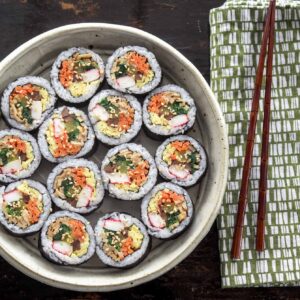
Kimbap (Korean Seaweed Rice Roll)
Recipe Video
Ingredients
For the rice
- 2 cups (480 ml, about 450 g) uncooked short grain white rice
- 2 1/2 cups (600 ml) water
- 2 tbsp Korean plum extract (maeshil cheong)
- 1/2 tsp salt
For the filling ingredients
- 6 strips pickled radish (danmuji), 1/2 inch thick, drained
- 6-12 strips braised burdock root (Oeong), drained
- 6 strips imitation crab meat
- 2 tbsp oil, divided
- 10 oz (283 g) package shredded carrot
- 2 tbsp water
- 4 eggs, beaten
For the fishcake
- 3 sheets flat fish cake, sliced thinly
- 1 tbsp soy sauce
- 1 tsp sugar
- 1 tbsp sweet rice wine (mirim)
- 1 tbsp corn syrup
For the spinach
- 1 bunch (12 oz, 340 g) spinach
- 2 pinches salt
- 1 tsp sesame oil
- dashes toasted sesame seeds
Equipment
Instructions
- For the rice: Rinse rice several times and drain. Soak rice in 2 1/2 cup water for 10 minutes. Cook rice until soft. Put hot rice in a large mixing bowl, add plum extract and salt; toss well. Cover rice with a kitchen towel and set aside to cool.
- For the egg: Beat eggs and cook in a skillet in 3 batches. Roll them up and slice thinly
- For the carrot: cook shredded carrot in a little oil over medium high heat with some salt. Add 2 tbsp of water to create a steam and cover with a lid. Cook for 2 minutes until crisp but tender.
- For the fishcake: slice fishcake sheets thinly and stir-fry in a little oil for 1 minute over medium high heat. Mix together soy sauce, sugar, and rice wine in a bowl, and add the mixture to the fishcake. Continue to stir-fry for another minute.
- For the spinach: blanch spinach in a pot of boiling water with some salt. Drain and rinse with cold water. Squeeze out the excess water. Place the spianch in a mixing bowl and season with salt, sesame oil, and sesame seeds. Toss well.
To assemble Kimbap
- Cut 3 sheets of seaweed in half and set aside.
- Place a full sheet of seaweed, shiny side down, longer side toward you, on a bamboo rolling mat. Spread about 1 cup of rice (1/6 amount) evenly on the seaweed leaving 1 inch of space at the end. Lay a half seaweed sheet in the middle of rice.
- Put filling ingredients on top of the half seaweed sheet in a contrasting color pattern.
- Lift the entire end of mat from your side with both hands, roll over to cover the fillings, tucking in the filling with your fingers. Put firm pressure on the roll and continue to roll again as you roll away the mat until it reaches to the end.
- Place the finished kimbap on a platter, seam side down, while you are making another. Cut kimbap into 1/2 inch thick slices with a sharp knife.
Notes
- If you want to season rice with sesame oil, toss rice with 1 tbsp sesame oil and 1/2 tsp salt.
- If you want to season rice with vinegar mixture; whisk together 4 tbsp rice vinegar, 2 tbsp sugar, 1/2 salt in a small mixing bowl. Microwave for 1 minute until sugar dissolves. Pour into rice and toss well.

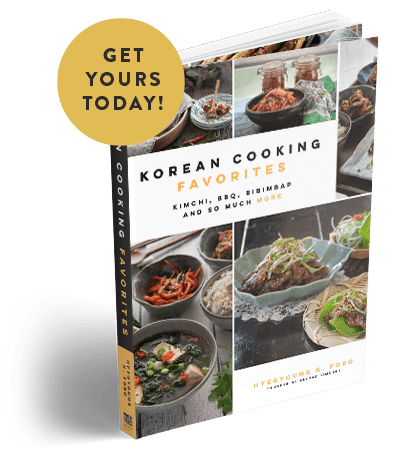
Hi Holly! Thank you so much for the recipe. Under notes, for the optional vinegar mixture for the rice, is it 1/2 tsp or 1/2 TBS of salt?
Hi Lucy
It’s 1/2 teaspoon of salt. Thanks!
I would love to try making kimbap, but I have trouble eating seaweed. Is there an alternative to seaweed that I could use?
Hi Jo
You can roll with cooked egg sheets. Check out my kimbap video to see how I made the egg sheet. In that case, you can omit the egg in the filling. Hope this helps.
Thanks for the recipe.
These are fun — look great, and I’ll bet they taste great. Agree with Angie that they look like a professional sushi chef made them. 🙂
I wasn’t familiar with kimbap before this post, but the process seems very similar to making sushi at home. There was a time (pre-child) that Laura and I used to make sushi at home. We still have the rolling mats and stuff…and you’ve inspired me to pull them back out sometime soon. This sounds like a fun recipe to make together on a weekend evening!
It is indeed fun to make kimbap especially with families. Hope you can try making one. You don’t have to put all the filling ingredients and be creative to make your own style.
I’ve never heard or even tried kimbap, but these rolls sound wonderful (Even though I might not be familiar with some ingredients). I also must admit the rolls look splendid and so neatly done – even layers, tightly rolled up. You don’t often see this quality even at a restaurant, and for some homemade rolls is is simply impeccable work!
I know some of the Korean ingredients are not common in America. Kimbap is becoming popular among many American these days. It take some effort to get them ready to roll, but worth the try. It is a wonderful finger food.
These look like from a professional sushi chef 🙂
Thank you.
is it absolutely required to use rice vinegar?
You can use white vinegar instead.
I have all the ingredients, and I’m excited to get started, however, all I could find was prefried fish cakes, do I still prepare it as suggested? Or do I just reheat them? Thanks for your help.
Hi Michelle
You can prepare it with the recipe to add more flavor or you can use as is. Usually it tastes better if you add the seasoning to the fish cakes. Have fun making them. They will be delicious!
Thank you Ms.Holly for a visually beautiful guide on how to make a kimbap! I’m really thankful for your detailed instructions which is easy to follow. And I have just read your introduction in the ABOUT page, aw, it so sweet of you Ma’am, to create this blog as a gift for your children.. May God bless you more Madamme and your family ’cause you deserve it!
P.S. What camera did you use Ma’am? You’re pictures are all good. ^v^
Thank you so much for your blog! My husband is half Korean, and my mother-in-law has taught me to cook a lot of Korean food. Your recipes are authentic and delicious 🙂 My mother-in-law doesn’t have her recipes written down, and whenever I refer to this blog when I have a question, it turns out just like hers! YAY! Thank you! Do you have a recipe for kongnamul soup?
I posted Beef and Bean Sprout Soup yesterday. Hope you get to try it. There are may versions of Kongnamul soup. I will remember to post as much as I can.
Hello, Holly! I’ve been reading your various recipes as I prepare for a big Korean lunch tomorrow with guests! I’m trying your cola braised Korean chicken + my other usual panchans. 🙂 I’ve made kimpop from another recipe, and they were good, but something was not quite right. I never steamed my carrots (!!) and I never rinsed the radish (!!!) which may be the missing steps. Thank you for the details that help a non-Korean wanna be chef!
Question: is there a specific way to cut the kim-pop? I’ve tried using different knives, but have trouble with my seaweed tearing or the kim-pop tearing apart while I try to separate them. Am I not pressing the roll tight enough? Any input is appreciated!!!
Thanks from your Padawan Learner,
Jessica 🙂
Hi Jessica
Sharpen your knife before cutting. Avoid serrated knife. Instead of pushing down motion, use jigsaw motion to cut through the seaweed layer. Also try not to cut each slice too thin, at least 1/2″ thick slices unless you have a very sharp knife. I usually wipe my knife with a damp cloth (or wet paper towel) per each kimbap roll before you cut to remove the stickiness from the rice in the previous roll. Basically you wipe off the sticky residue from your knife every roll you cut.
Coat your kimbap roll with a little sesame oil or other oil by using your hand or brush, just to bring a little shine. It also help strengthen the seaweed.
Hope all these tip will help. Tearing happens sometimes but I like it because the torn piece can go into my mouth immediately. 🙂
I realy like your blog. This is the first time I see this blog. Yes, i like the way you show how to roll the kimbap. Thank you for sharing.
How to keep the rice rolls fresh if made them a day before?
Thanks.
You can’t. You need to consume on the day you made. They don’t keep well in the fridge.
Wow!! you my friend are just simply AMAZING!! I love the humor you bring to the table so to speak =) I just wanted to say that the recipe you have listed is the best one I have came across so far *and my search is done now since I found you* Thank-you for being so awesome!
How would the rice cooking change if I want to use brown short grain rice instead?
I made these for my family and they turned out great! Thank you for this recipe!
김밥에 김치하고 함께 먹어도 너~~~~~~~~무 맛있어요^^
캬! 맛있죠 그렇게 먹으면…
I love your recipe.. And i really enjoy your story.
Hi! I loved reading this post! Thank you! Great stories that made me laugh! I was inspired to make Kimbap and blogged about it at http://foodflavorfascination.wordpress.com/2012/10/19/black-beauty-kim-bap/
I love how you called the Kimbap “Black Beauty.” It reminded me of some memories.
I’ll have to try making the pickled radish too.
Thanks Samantha. You did a great job with your kimbap.I enjoyed reading your post.
Our family loves making and eating kimbap! We play around with the fillings – sometimes adding different things like avocado, cucumber or kimchee. But I don’t like that there is saccharine in the pickled radish. The radish is really an essential flavor that is needed and the kimbap tastes bland without it. So my question: is there a way to make the pickled radish at home, so that I can keep the saccharine out?
Also – I loved your story about your childhood friend. Now everytime I make kimbap for my daughter’s lunch I hum Billy Jean to myself and smile!
Hi Linda
Yes, you can make pickled radish at home. Get a Korean or daikon radish and and slice into long strips (the size you desire for making kimbap). Sprinkle 1/4 cup of coarse salt per radish and let it soak for 1 hour. Drain the liquid that has been extracted from the radish.
In a pot combine 1 cup vinegar + 1/2 cup water + 1/4 cup sugar together and bring to a boil stirring to dissolve the salt. Remove from heat and pour over the radish. Let it sit in the room temperature for 4 hours, then keep in the fridge for 3-4 days and your radish will be ready to serve. Store them in the fridge for as long as you want.
It is nice that your family enjoy making Kimbap. It is a great family activity, isn’t it?
Delicious! Mine didn’t look like the picture, but they were still good.
I believe that taste is more important than the look when it comes to a food. Glad to hear you liked it. Thanks!
May I ask, why must we put kelp into the rice in water?
Hi, the rice seasoning in this kimbap recipe is closed to the Japanese sushi rice which my family often use. Sea kelp adds nice flavor. You can omit the kelp if you prefer without it.
Wow, this looks delicious. I must try it sometime soon. I love sushi of all forms and although there is no raw fish here, it looks delicious. I am not sure where I would find the fish cake, but I am sure I can substitute.
Yum I love whenever my mom makes this! Hopefully I can make it for myself now.
Yes. If you are doubling the amount of rice, you can double the vinegar seasoning mixture as well. You've must made them very well last time. They like to put you to work! Have fun making them!
Hi there! I made this recipe the other day and now I've been asked to repeat it again, but for double the people! Can you simply double the rice and vinegar portions? Or should it be to some other ratio? thanks!
Wow. Looks fabulous, I am going to give this a try.
Hi Lori
rice vinegar is the best option but if you can't find one, sub with sherry
wine vinegar or white vinegar. Use a little less amount since rice vinegar
is milder than the other kinds.
Hope you enjoy your stay in Egypt.
Holly
ohh, this brings me back to my days living in seoul! i miss kimbap! I have a question. I live in Cairo now, and their rice is short grain so I think it will be fine…IF I can't find (or afford at the expensive import stores) rice vinegar, what do I do???
Thanks!
@ce447ac57cc910942e49530e7174c48d:disqus
I don't use dipping sauce. It is just good to eat without it. However, I often make simple miso soup to go with though.
I'm so excited to try this recipe. It looks delicious and it's one of my favorite things! Is there a dipping sauce you usually make with it?
@9ddada242b78c88059a25a727b6c7e93:disqus
Hope you can make Kimbap soon. Yes, I agree that the surprise is doubled because it exceeds the expectation you had. Thanks.
@4bed61f208a84803d3710771a1019d05
Thanks Rowena.
Your kimbap looks so mouthwatering…! Everytime I a visit a blog and somebody makes kimbap or sushi, I always think, 'I need to make this tomorrow!' ;). The story of that old classmate of yours is so funny, but often quiet people have got surprising talents. And the surprise is often doubled, because they tend to be so introvert and quiet ;).
I like how you are so precise with your step-by-step food pics (never would have thought about cooking rice in a cast iron pot), but that memory about Mi-gyoung is too precious! You're not only a fantastic cook, but also a great storyteller.
kimbap always reminds me of being a kid. we always had it for road trips and picnics too, i really should make some!
Oh, this is bringing back so many lunchtime memories! I'm half-Korean and grew up in the States, and sometimes my mom would pack kimbap for my lunch, which I loved, except when some other kids teased me for my "weird" food!